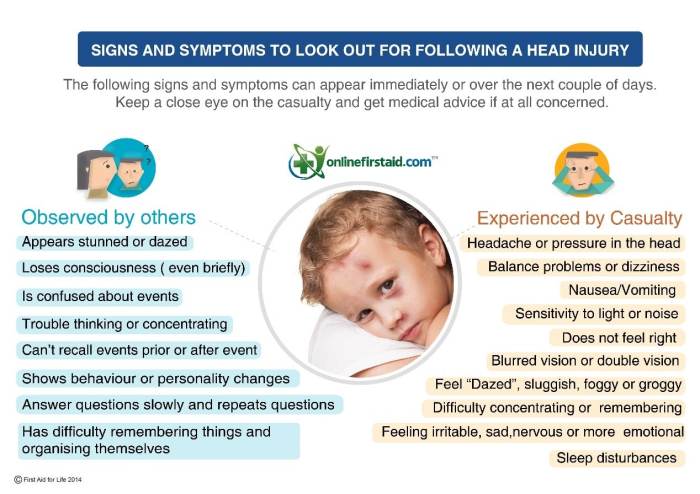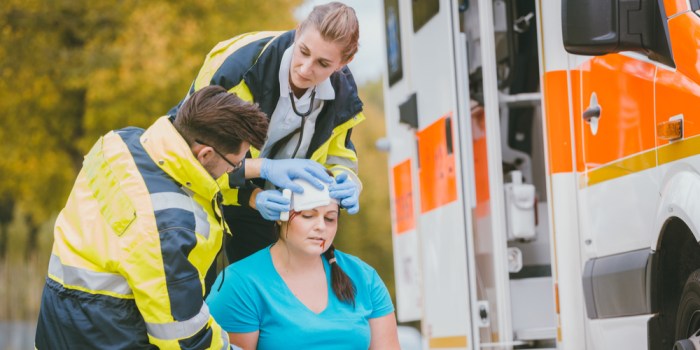
Emergency Care for Head Injuries sets the stage for this enthralling narrative, offering readers a glimpse into a story that is rich in detail with casual formal language style and brimming with originality from the outset.
Head injuries can be serious, requiring prompt and appropriate care. Understanding the importance of immediate medical attention and knowing how to respond effectively is crucial in ensuring the best outcomes for those affected. This article delves into the essential steps and procedures needed in emergency situations involving head injuries, providing valuable insights for both laypersons and healthcare professionals alike.
Emergency Care for Head Injuries

Head injuries can be serious and require immediate medical attention to prevent further complications.
When responding to head injuries, the initial steps are crucial in ensuring the safety and well-being of the individual.
Assessing the severity of head injuries before administering care is important to determine the appropriate course of action and prevent potential risks.
The Importance of Immediate Medical Attention
Head injuries can have varying degrees of severity, from mild concussions to life-threatening traumatic brain injuries.
- Immediate medical attention can help in diagnosing the extent of the injury and providing timely treatment.
- Delay in seeking medical care for head injuries can lead to complications such as brain swelling or internal bleeding.
- Early intervention can improve the prognosis and reduce the risk of long-term consequences.
Overview of Initial Steps
When responding to head injuries, the following initial steps should be taken:
- Assess the situation and ensure the safety of the individual and others around.
- Check for responsiveness and breathing, and call emergency services if necessary.
- Stabilize the head and neck to prevent further movement that could exacerbate the injury.
- Apply direct pressure to any wounds or bleeding to control the bleeding.
Significance of Assessing Severity
Assessing the severity of head injuries is crucial for the following reasons:
- It helps in determining the appropriate level of care needed, whether it be at home, urgent care, or the emergency room.
- Knowing the severity guides healthcare providers in deciding on diagnostic tests and treatment options.
- Understanding the extent of the injury allows for better monitoring and management of potential complications.
Symptoms and Signs
Head injuries can vary in severity, and it is crucial to recognize the signs that indicate the need for emergency care.
Common Symptoms and Signs
- Loss of consciousness
- Confusion or disorientation
- Persistent headache
- Nausea or vomiting
- Unequal pupil size
- Slurred speech
Recognizing Mild vs. Severe Head Injury Symptoms
Mild head injury symptoms may include a brief loss of consciousness or a headache, while severe head injury symptoms often involve prolonged unconsciousness, severe headache, or repeated vomiting.
Visible Signs of Serious Head Injuries
- Bruising or swelling at the site of impact
- Clear fluid draining from the ears or nose
- Unequal pupil size
- Convulsions or seizures
First Aid Procedures
When providing first aid for head injuries, it is crucial to follow proper procedures to ensure the safety and well-being of the individual. This includes stabilizing the head and neck, controlling bleeding from head wounds effectively, and positioning the person correctly to prevent further damage.
Stabilizing the Head and Neck
- Approach the person carefully and assess the situation before touching them.
- Support the person’s head and neck in a neutral position to prevent any movement.
- Avoid moving the person unless absolutely necessary to prevent aggravating any spinal injuries.
Controlling Bleeding from Head Wounds
- Apply direct pressure to the wound using a clean cloth or bandage to stop the bleeding.
- Elevate the head slightly to reduce blood flow to the area.
- If bleeding persists, continue applying pressure and seek medical help immediately.
Positioning a Person with a Head Injury
- Lay the person on their back, keeping their head and neck in alignment.
- Avoid tilting or turning the head to prevent spinal cord injuries.
- If the person is breathing normally, keep them in this position until medical help arrives.
Emergency Medical Response

In the event of a head injury, it is crucial to act swiftly and call for emergency medical assistance. Here are the steps to follow when calling emergency services for a head injury:
Calling Emergency Services
- First, dial the emergency number in your area, such as 911 or 999, immediately.
- Provide clear and concise information about the situation, specifying that it is a head injury.
- Follow the dispatcher’s instructions carefully and stay on the line until help arrives.
Information for Emergency Responders
- When emergency responders arrive, provide details about how the head injury occurred, the symptoms observed, and any first aid measures taken.
- Inform them of any pre-existing medical conditions or medications the injured person may have.
- Be prepared to answer questions and provide as much information as possible to assist the responders in their assessment and treatment.
Importance of Staying with the Injured Person
It is vital to stay with the injured person until medical help arrives for several reasons:
- Provide comfort and reassurance to the individual, helping to reduce anxiety and stress.
- Monitor the person’s condition and be prepared to provide additional information or assistance to the emergency responders.
- Ensure the safety and well-being of the injured person, preventing further harm or complications.
As we wrap up our discussion on Emergency Care for Head Injuries, it becomes evident that quick and appropriate actions can make a significant difference in the outcome of such situations. By being informed and prepared to handle head injuries effectively, we can contribute to better overall care and potentially save lives. Stay vigilant, stay informed, and always prioritize safety when dealing with head injuries.
Essential Questionnaire
What are the common symptoms of a severe head injury?
Common symptoms of a severe head injury include loss of consciousness, persistent headaches, vomiting, confusion, and unequal pupil size.
How should you position a person with a head injury to prevent further damage?
It is crucial to keep the head and neck stable in a neutral position to prevent any potential spinal cord injuries. Avoid moving the person unless absolutely necessary.
What information should you provide to emergency responders about a head injury?
When calling emergency services, be prepared to provide details about the cause of the injury, any visible symptoms, the person’s current condition, and any first aid measures already taken.





